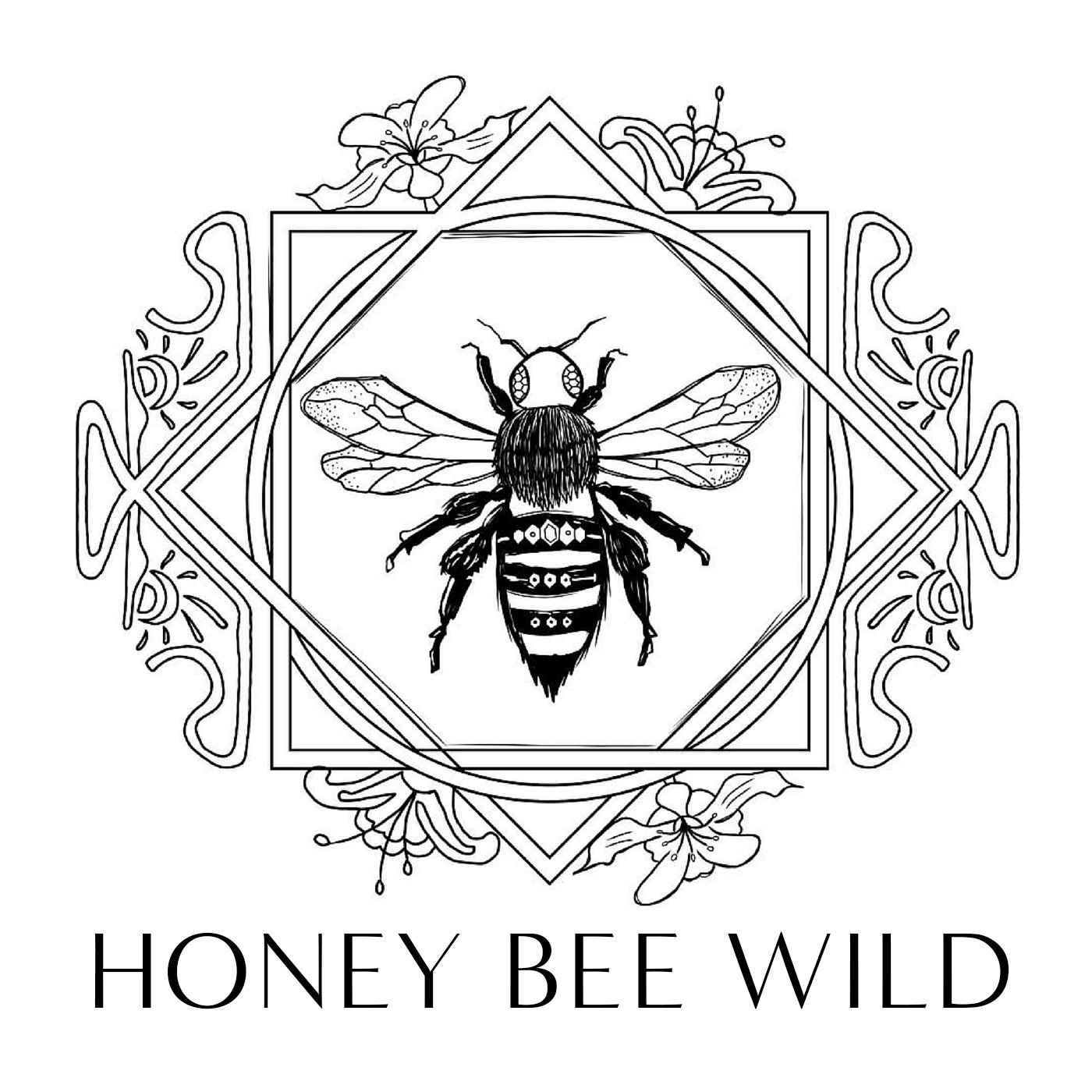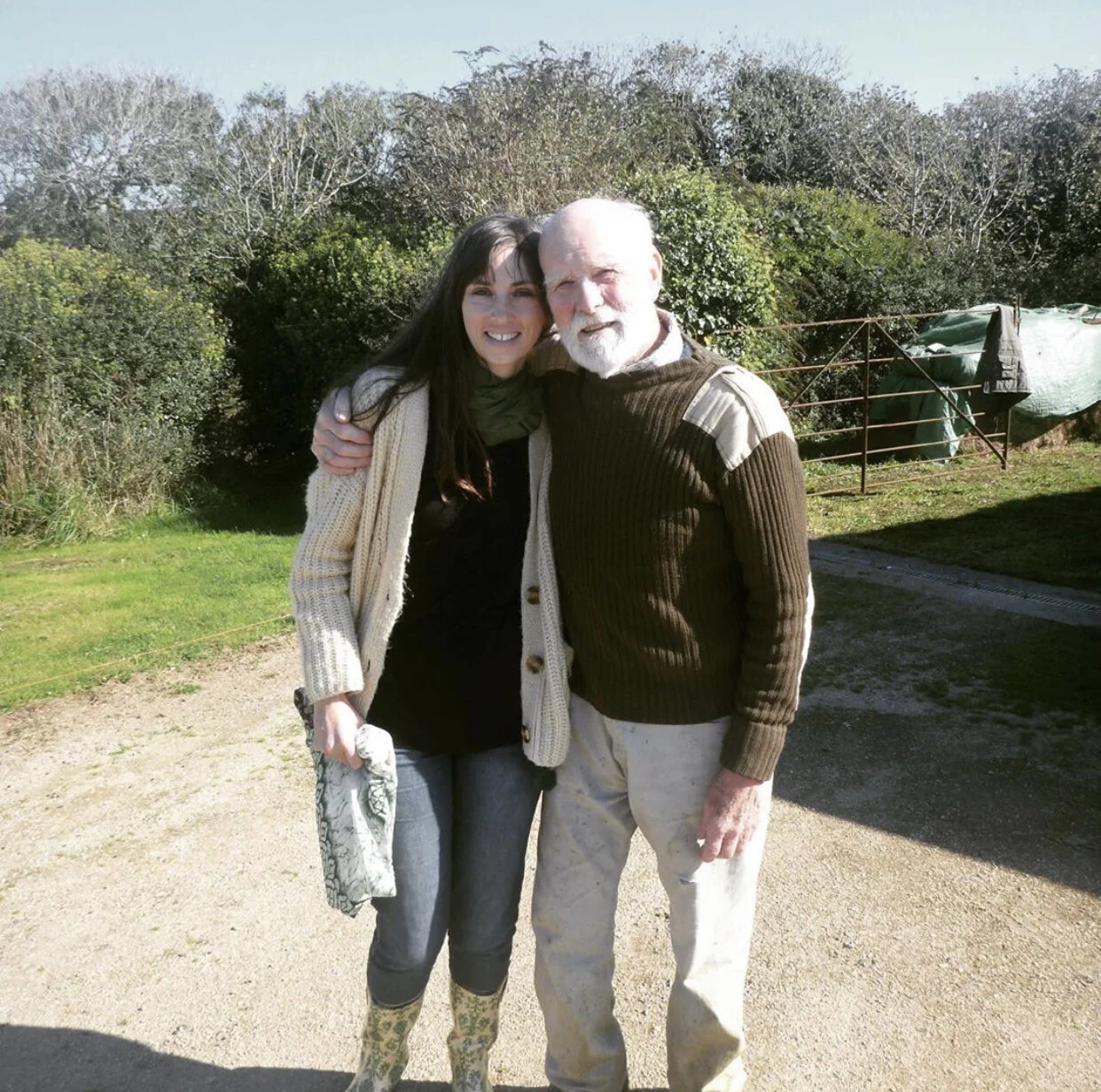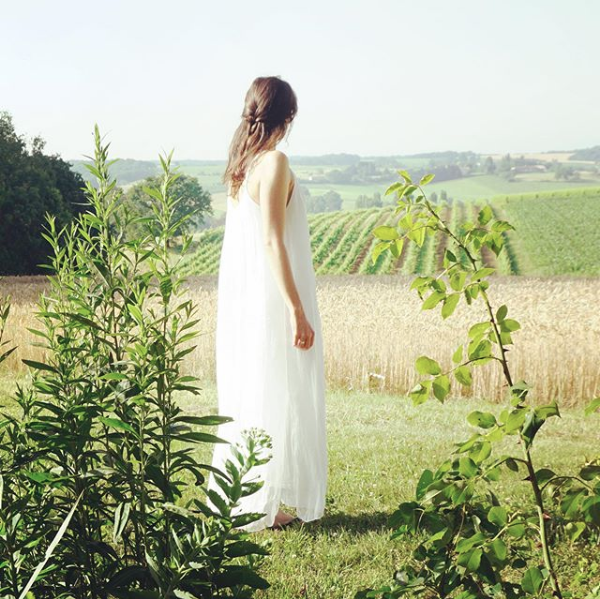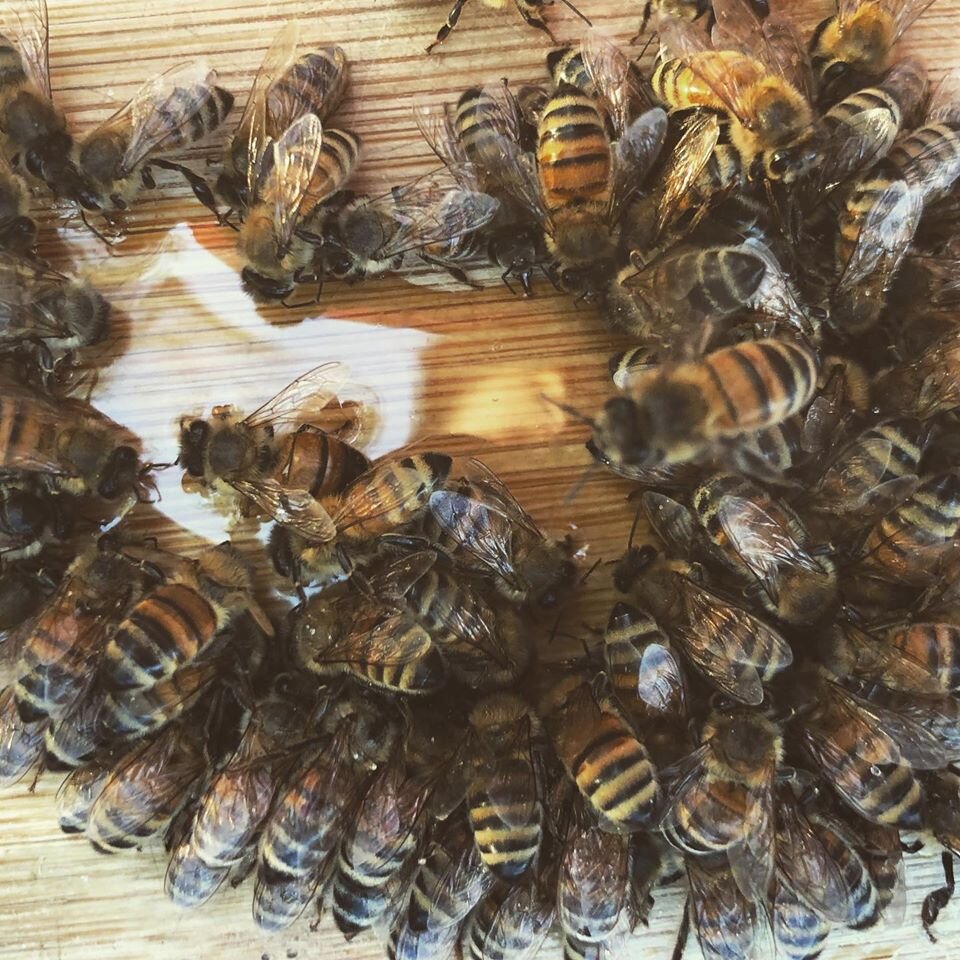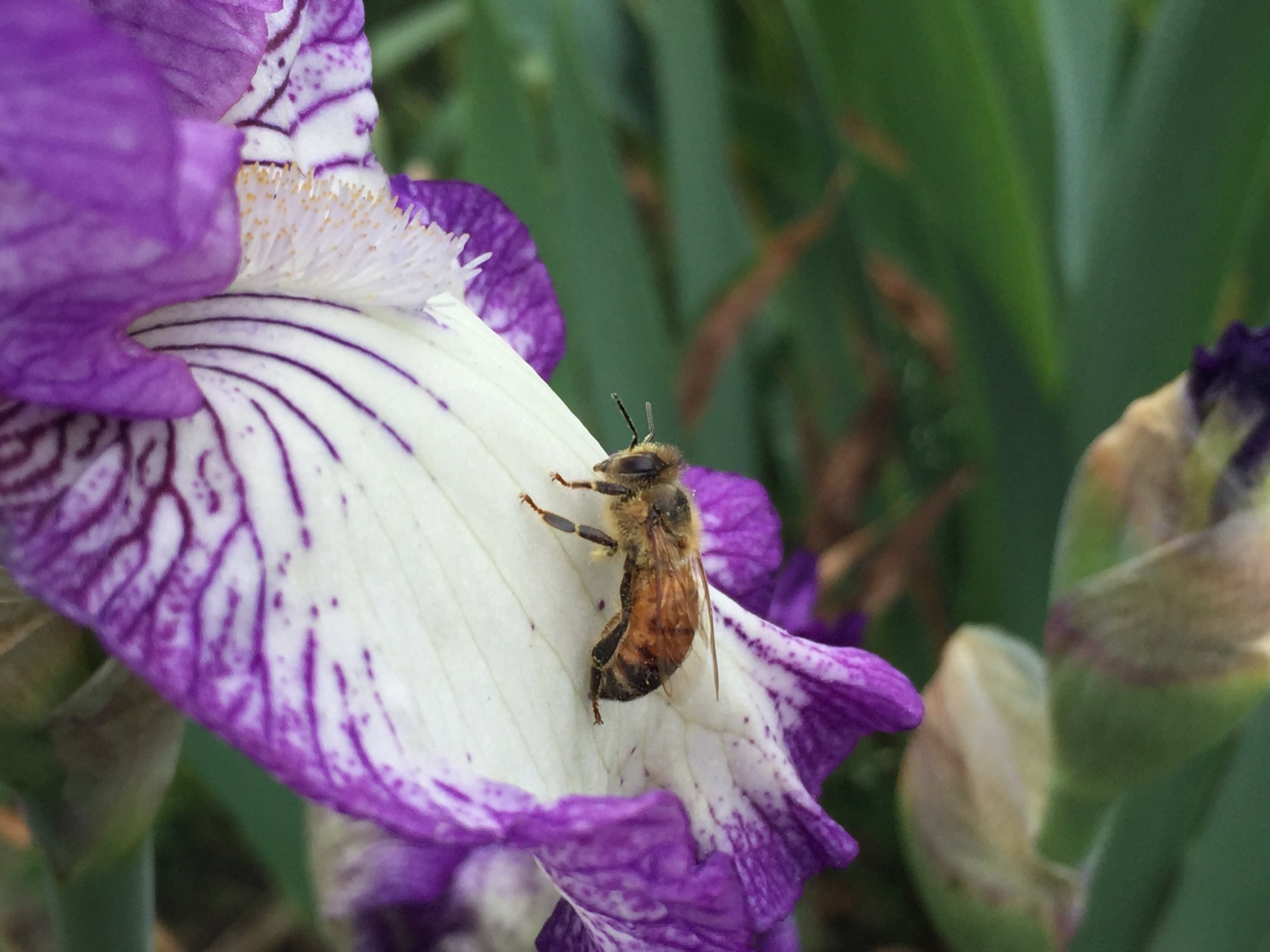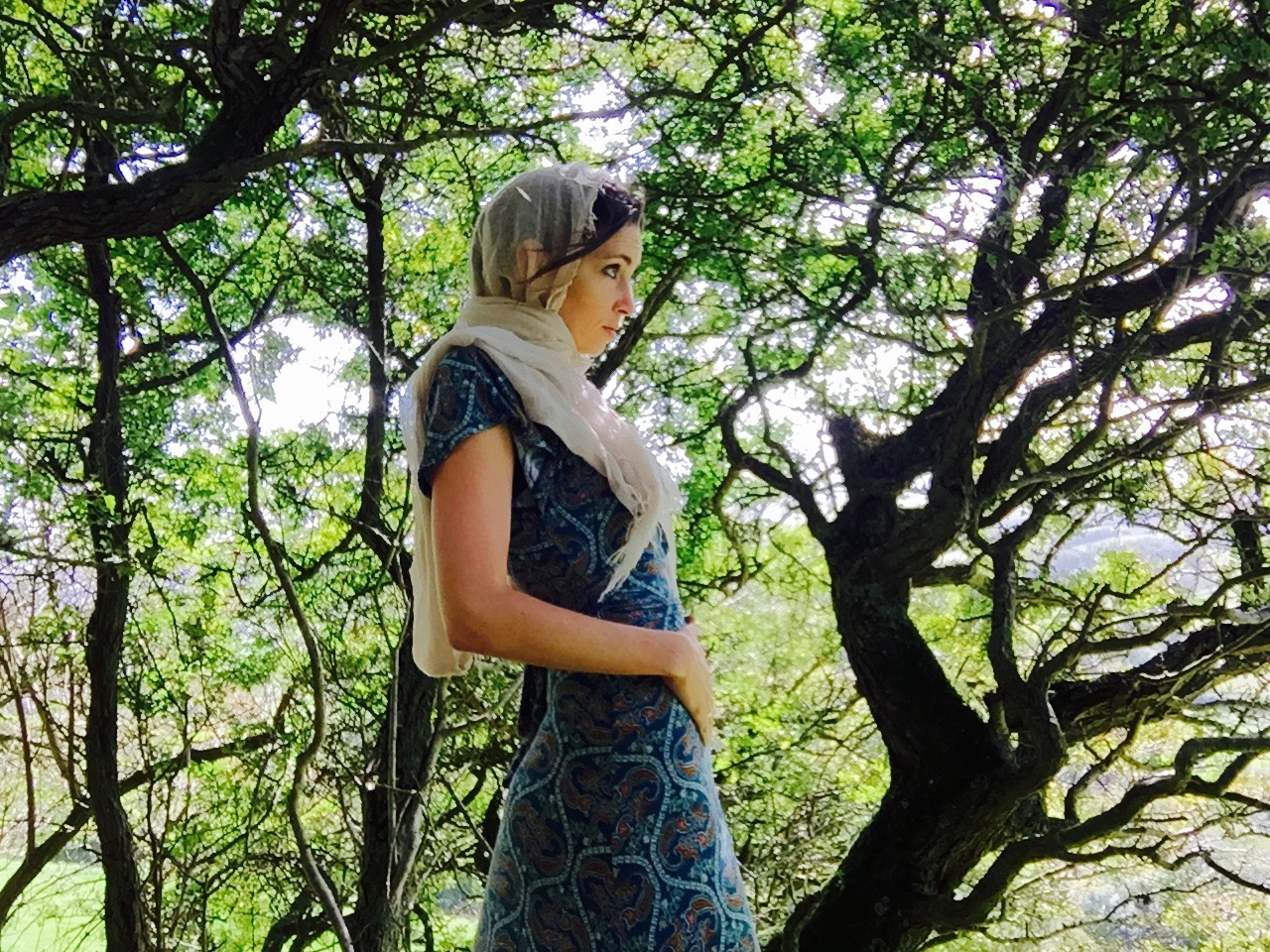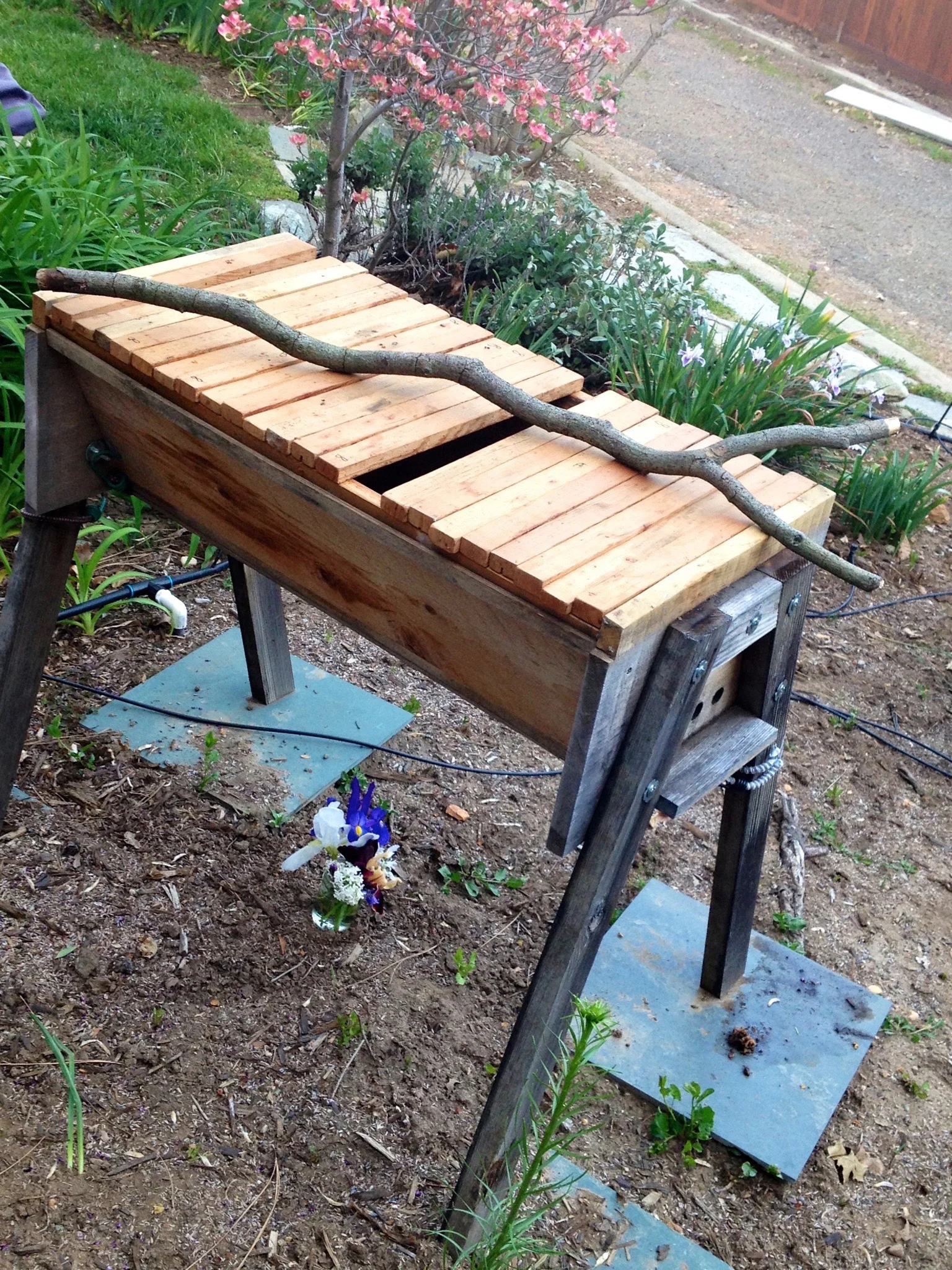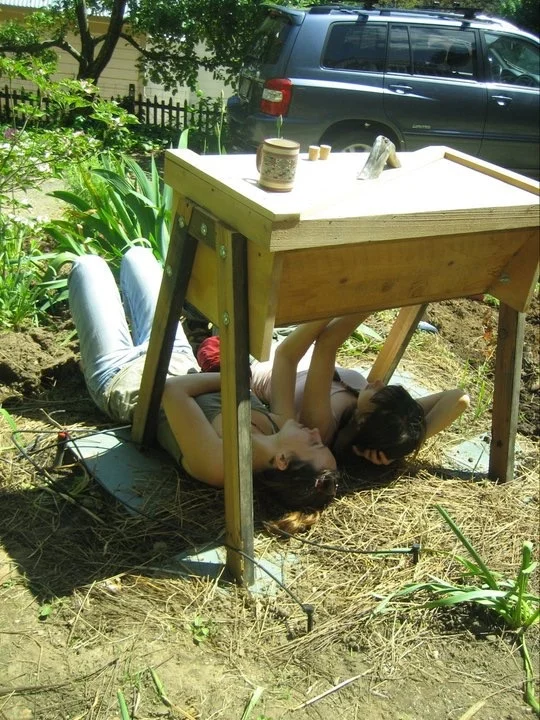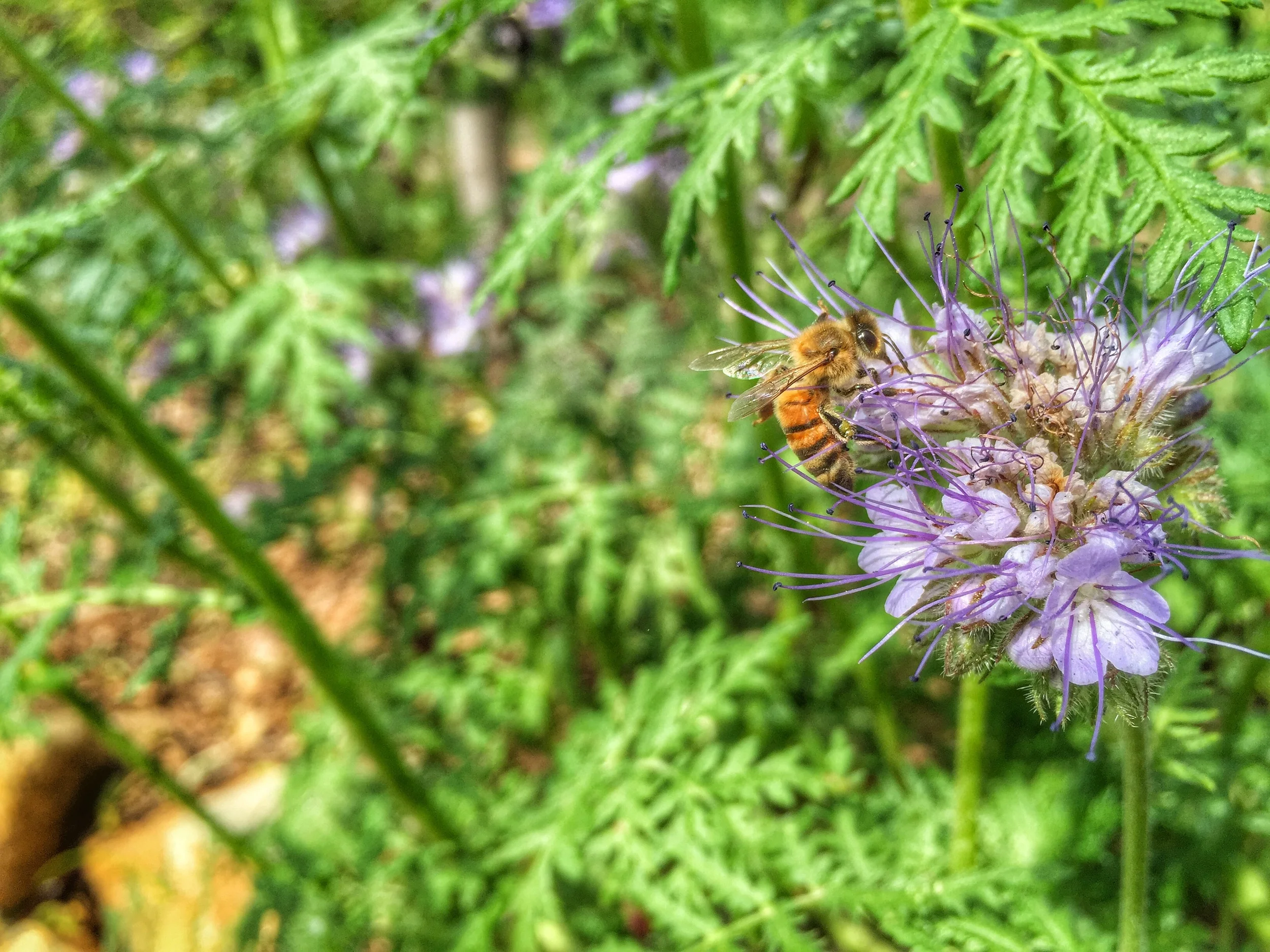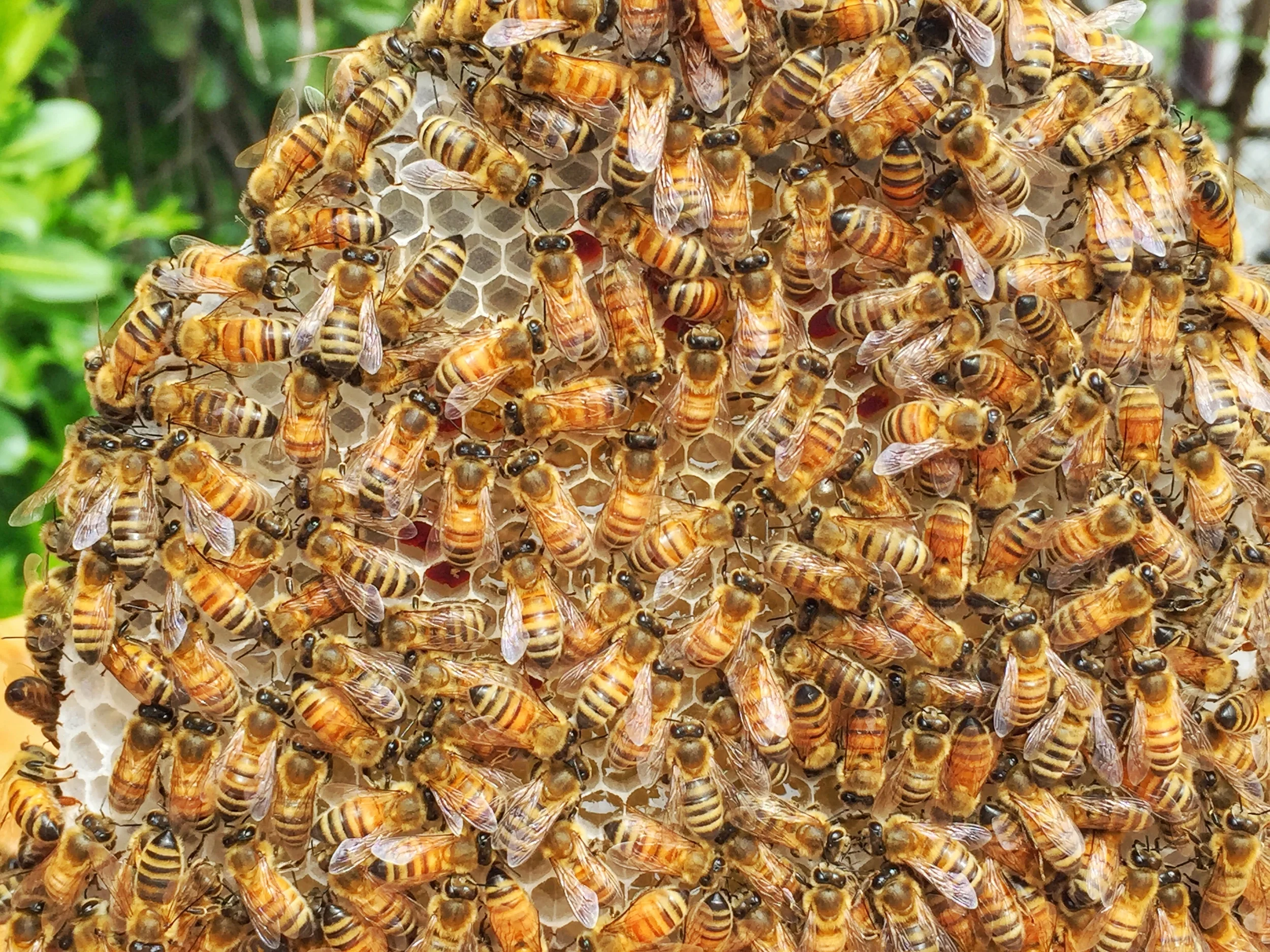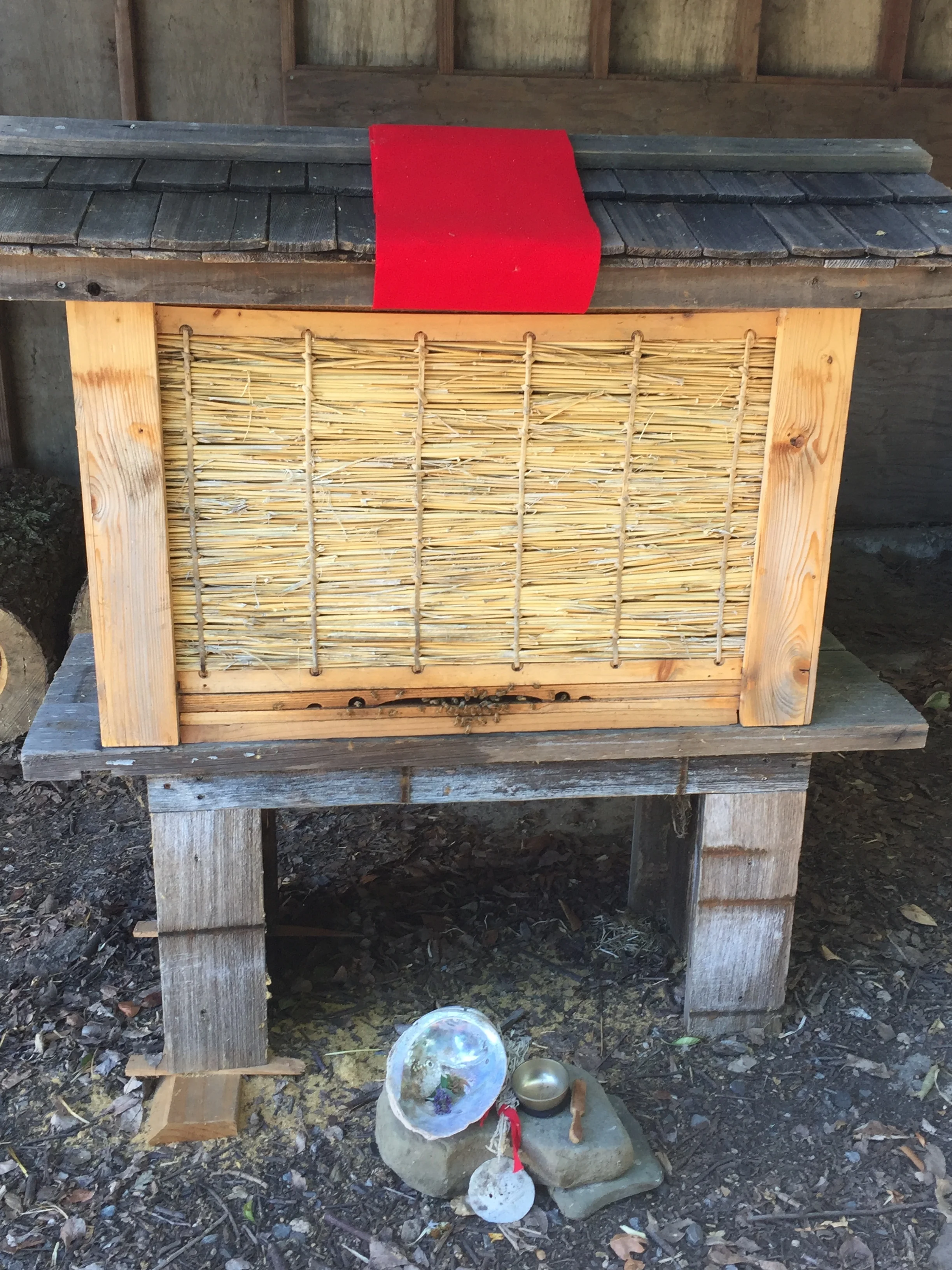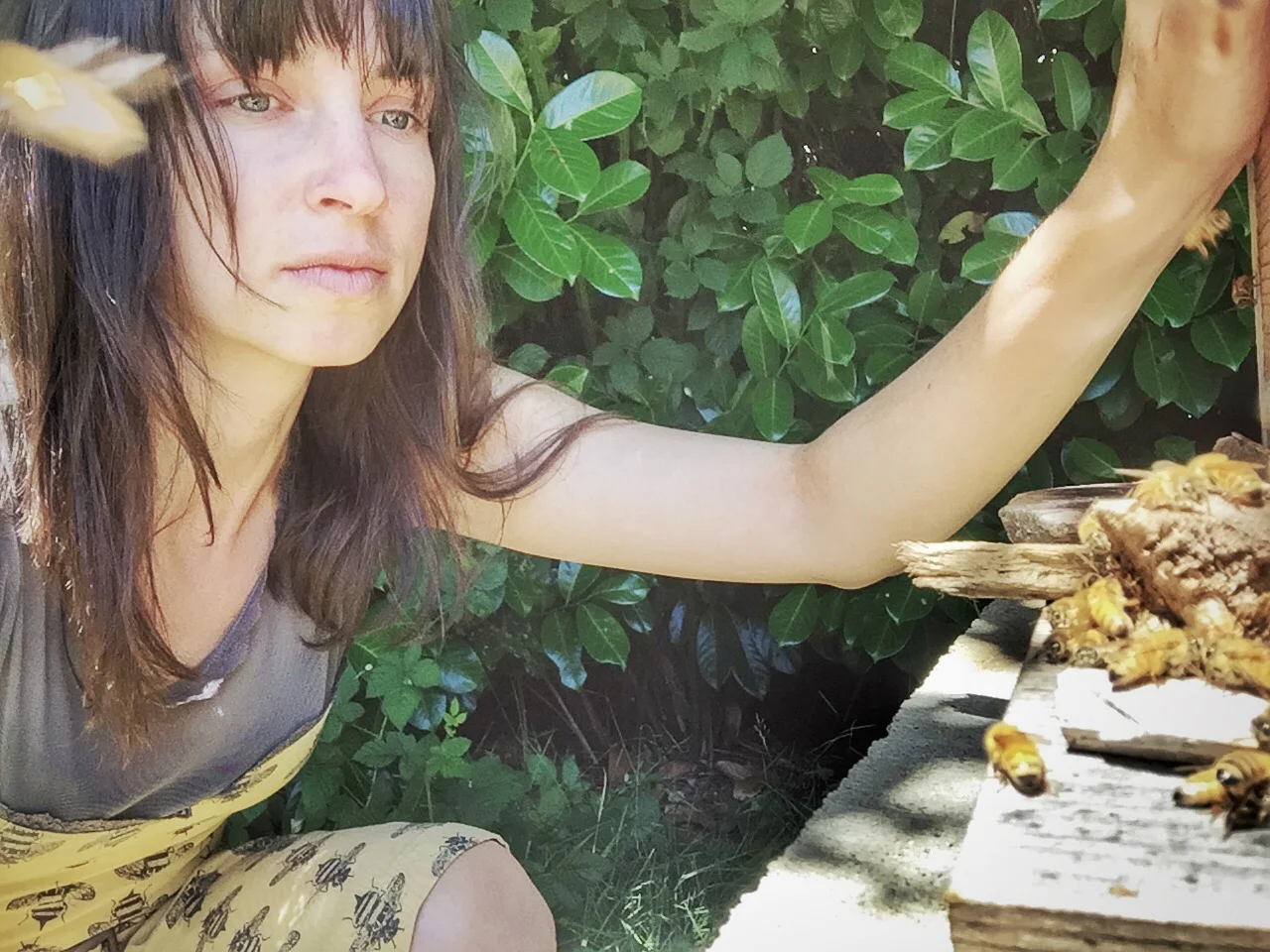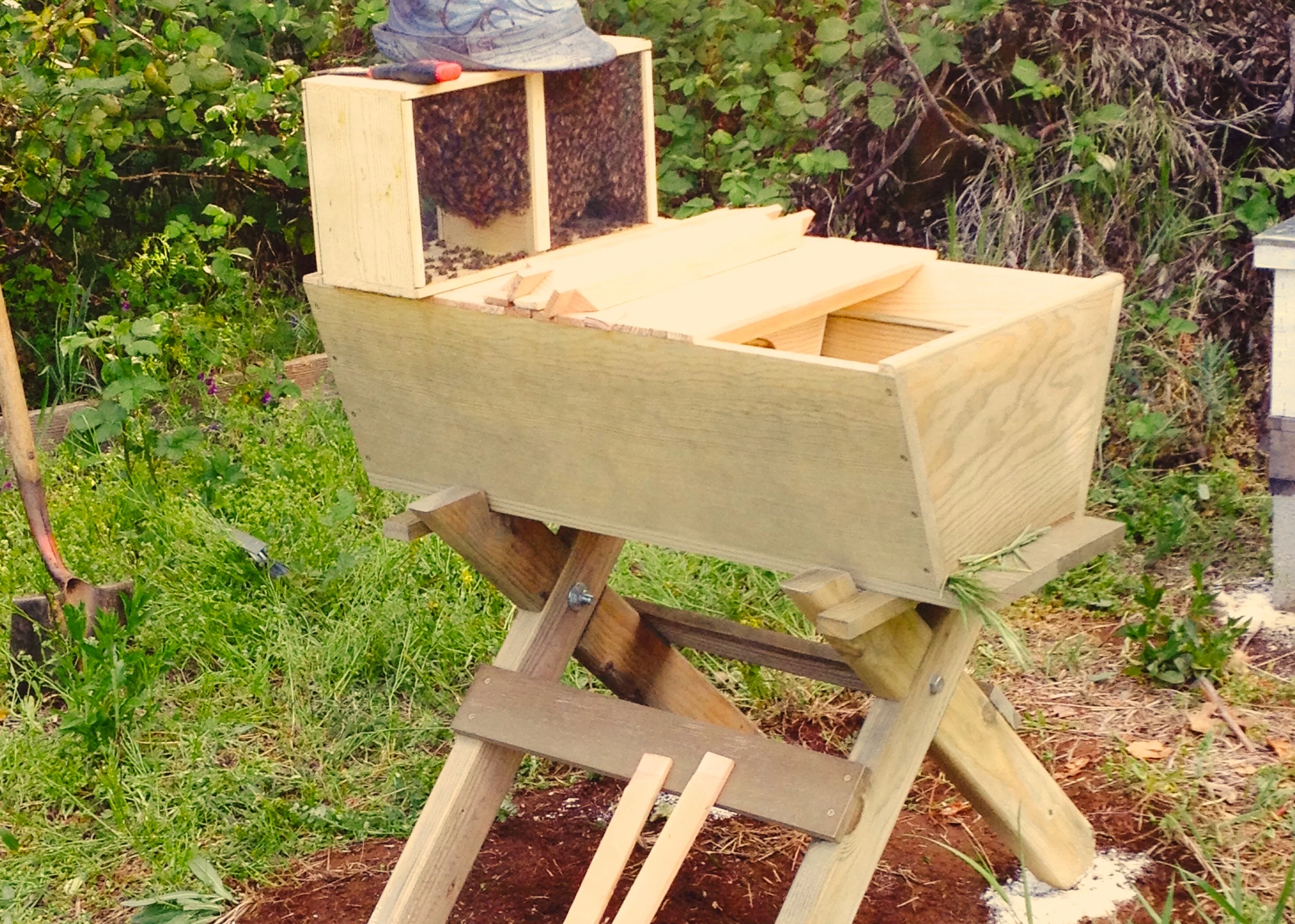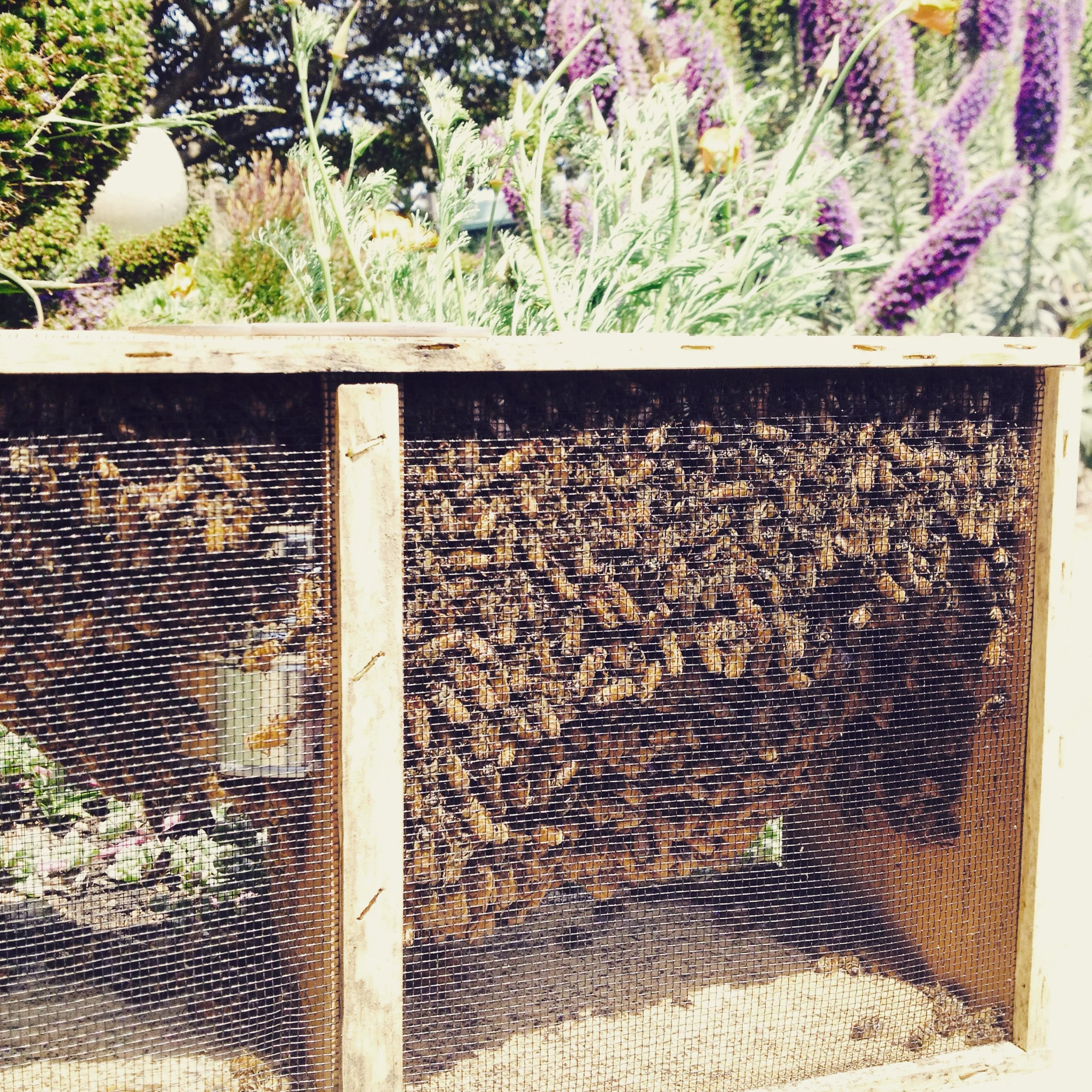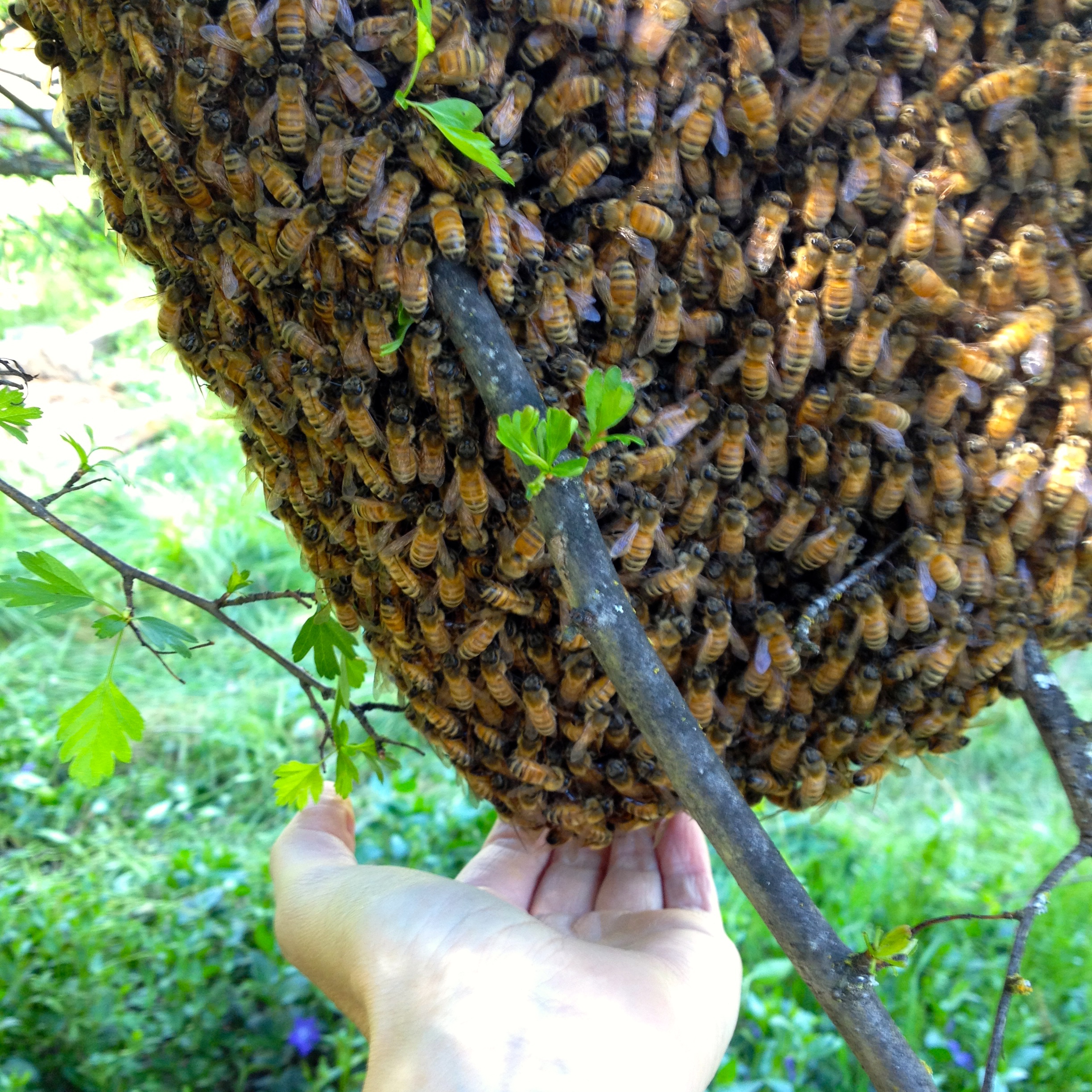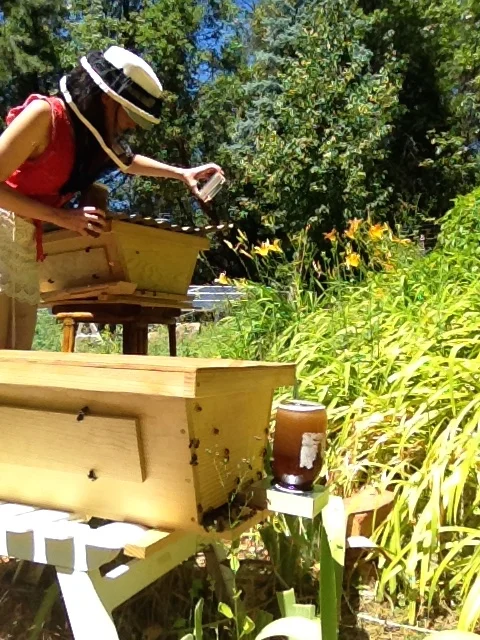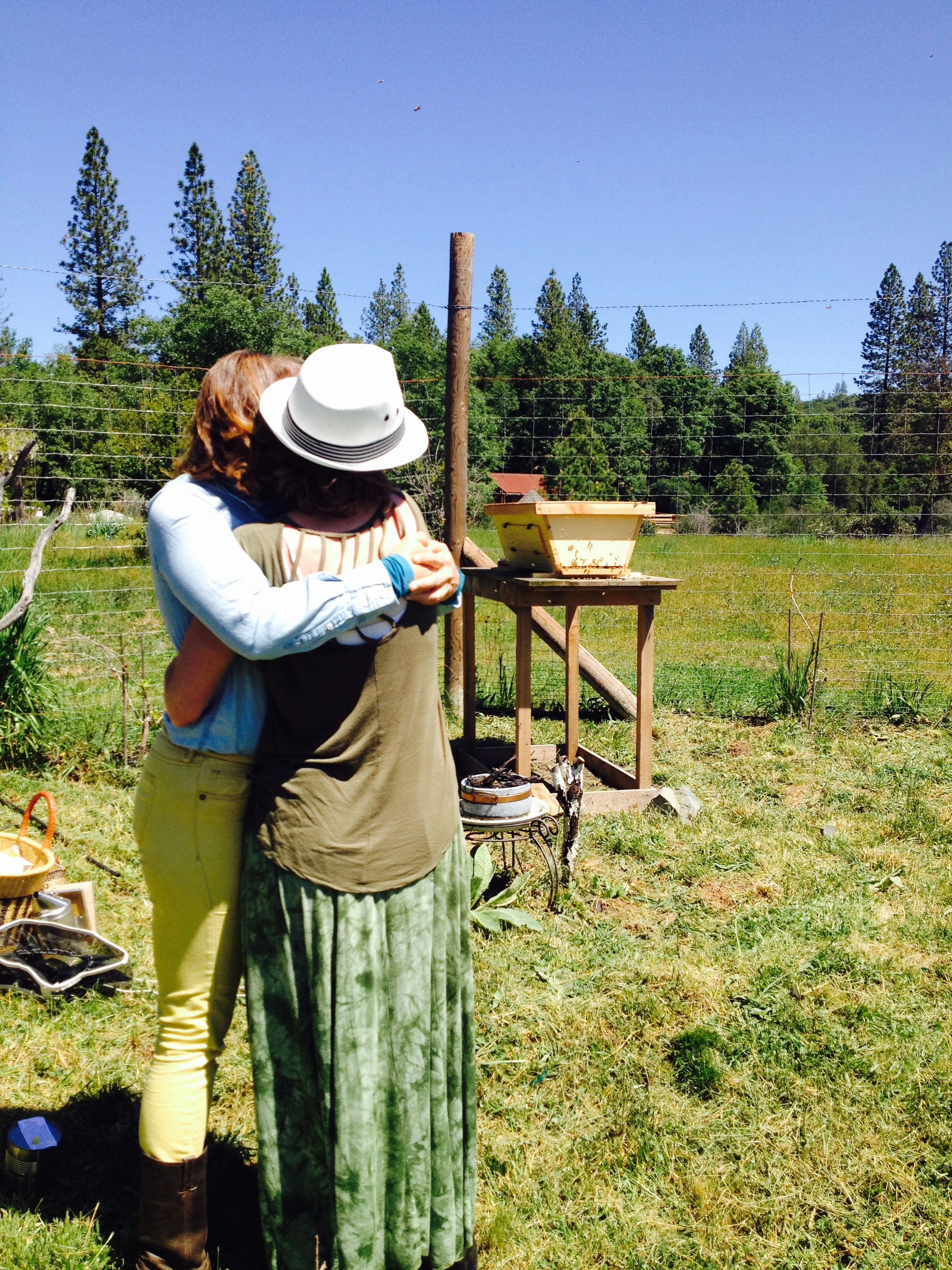Death of a Colony
When a colony dies, it’s important to investigate the cause so that, perhaps, you can improve in your stewardship the following year. This is a photograph of a colony that lost their queen. What you see are a number of emergency queen cells. There were more on the other side of the comb.
When a colony dies, it’s important to investigate the cause so that, perhaps, you can improve in your stewardship the following year. This is a photograph of a colony that lost their queen. What you see are a number of emergency queen cells. There were more on the other side of the comb. Emergency queen cells are different than swarm cells. Swarm cells are found along the bottom and edges of the comb, often preceded by queen cups, which the bees have been diligently preparing for the potential queen larvae. They invite the old queen to lay eggs in these cups, and start a daughter queen and hopefully a new colony.
Emergency queen cells are built directly on the face of the comb when the bees suddenly loose their queen and don’t have queen cups prepared.
An egg can only be turned into a queen in the first three days of gestation, before it hatches. That means the bees have three days to raise a new queen, and if they miss the window, there’s no hope for the colony.
Why did this colony loose its mother? She was killed by yellow jackets wasps.
In a bad wasp year like this one, yellow jackets will attack a colony, biting off the heads of bees, eating larvae, killing the queen, and eating honey. The bottom of the hive was littered with the bodies of bees with their heads bitten off. I’ve never seen it so bad. This was a strong colony, but the yellow jackets were stronger.
What makes it a bad wasp year? A preceding mild winter and lots of dry conditions. A mild winter means some wasp queens survive and start raising their young early. With a wet, lush spring and summer, they have lots of other food sources, but if it’s 90 degrees in early May and dry AF all summer, the wasp population skyrockets. Furthermore, bee colonies hit their peak population in midsummer, they start to diminish in size, whereas yellow jackets hit their peak numbers in late summer and fall. This equation can spell doom for the bees.
This colony had a strong brood pattern and lots of honey, but the excessive heat and months of wildfire smoke weakened them to the point of vulnerability, and once the wasps took out the queen, that was it.
#bees #queenbee #yellowjackets
The Courage to Steward Hives
Rendering comb down to golden disks of beeswax is one of the ways I process the loss of a hive. By giving my attention over to extracting the pure, golden, divinely scented wax from the skeleton of a hive, I feel connected to the life-death-life cycle of that hive.
Rendering comb down to golden disks of beeswax is one of the ways I process the loss of a hive. By giving my attention over to extracting the pure, golden, divinely scented wax from the skeleton of a hive, I feel connected to the life-death-life cycle of that hive.
I was on a walk this morning with one of my friends Michael Thiele of Apis Arborea. He establishes nest sites for apian beings (bees) in various watersheds, both rural and populated areas. Mainly log hives, which as a more natural home for honeybees. We were discussing the challenges of caring for bees as “treatment free” stewards amidst a culture and beekeeping climate of mass importation of commercial bees to our area and what that does to the population of locally adapted bees. We came up against the dichotomy of experiencing a sense of seasonal dread of loss with a surrender to the greater not knowing of what’s possible if we continue to try our best to listen to the innate impulse of the bees and how they live. It brought us to questions, as our talks often do, of language around beekeeping. What does it mean to be a keeper? What does it mean to be a steward? Or a witness?
I think to steward habitats for bees in a bee-centric model requires a tremendous amount of courage, because to do so means you will be forced to witness climate change first hand. You will not be able to turn away from biodiversity loss. From habitat destruction. However, in presencing ourselves with the bees, and being willing to listen and watch, we start to create and internal path that goes beyond grief, denial and apathy, and towards a constant and subtle shifting of one’s world view. We can’t change the world until we remember that we are nature, and from nature, life finds a way.
She Survived
Once, I drove through the narrow country roads of west Cornwall to find a sacred well. It was autumn and the sea looked Caribbean turquoise. The map wasn’t very good, but my friend and I found the well, partially overgrown with ivy, but not forgotten. One of the old places, where women’s water wisdom once offered healing and insight. A nearly obscured heritage. ⠀
Once, I drove through the narrow country roads of west Cornwall to find a sacred well. It was autumn and the sea looked Caribbean turquoise. The map wasn’t very good, but my friend and I found the well, partially overgrown with ivy, but not forgotten. One of the old places, where women’s water wisdom once offered healing and insight. A nearly obscured heritage. ⠀
The land owner, Trevor, met us at the gate, literal pitchfork in hand. He was happy to see us. He had learned a thing or two since he took over care of the property. He spoke to us of moon pools and the goddess Diana. He said Druids and shamans and all manner of pagan folk had visited the well over the years. It’s important, he said, because a well like that must be tended. He sent us on our way, we made our prayers, left our offerings and wondered at the lost ancient ways weeping through our veins.⠀
Then Trevor asked us in for a sherry. You never refuse a sherry from a white bearded farmer guarding a sacred well. There are rules. ⠀
Inside there was a spinning wheel and herbs. There were stacks and stacks of books. There was the love of a wife long past. Trevor handed us sherry in tiny glasses as said, “You know, this home used to be the home of a famous herbalist. Jessica was her name. She lived here in the 1600s. She knew how to make the secret preparations to call down the bees.”⠀
There it is. Not a mention of bees from my lips and here, this agnostic, curious farmer is telling me about the bees. How she could get them to swarm into the house. How she would heal the people with their remedies. She may have survived despite her arts, when so many women of her time perished. She who lived with these walls, and drank from the well, and walked in the ways of women’s mysteries. She who lived in a time when herbalist was synonymous with witch. Her wisdom meant death.⠀
Dear you, who tends the garden and sings to the bees in 2019, know that the thread survived in you. Remember that no matter how hard the men of the church tried to take women’s spirituality away from them, it survived, because it’s in you now.
They took the power of your weaving chants and called you an enchantress. For this you burned. They said no one could chant words of power but men. They took your healing arts and called you a witch. For this you drowned. No one could heal, save the grace of God and his doctors. They took your words and turned them against you. For this you were silenced.
But you survived, because the songs you wove were strong and made of the earth herself. You survived because you felt the warp and weft of life and death move through your own lunar tides, and you came to know cycles. You survived because you knew that someday you would be borne into the rich blood of your distant granddaughter and she would learn the secret ways to make preparations to call down the bees.
When the Death Goddess Comes
We’ve given her many names: Callieach, Persephone, Nepthys, Kali. But her original name was Earth. Mother. Crone. Womb and Tomb. There is no death goddess who is not also tied to, or herself a goddess of rebirth. They are not separate, because life is not, and never can be separate from death. This is why the Kelts built passage tombs or long barrows. We are born of the Mother and return to the Mother, her dark and earthly embrace.
We’ve given her many names: Callieach, Persephone, Nepthys, Kali. But her original name was Earth. Mother. Crone. Womb and Tomb. There is no death goddess who is not also tied to, or herself a goddess of rebirth. They are not separate, because life is not, and never can be separate from death. This is why the Kelts built passage tombs or long barrows. We are born of the Mother and return to the Mother, her dark and earthly embrace.
In the modern era we often associate bees with symbols of abundance, industriousness, and springtime. However, bees have also long been associated with death in equal measure. Bees and beehive are common symbols on tombstones, even within the Christian Era, but their association with death stretches deep into antiquity, where bees were seen by many cultures, including the Greeks and the Kelts, as messengers who could travel between the worlds, including between this life and the afterlife. This is part of the origins of Telling the Bees, when bee hives were visited after a death in the family to tell the bees of the loss.
Bees seem to be born of the Earth Mother herself, issuing forth from dark caves, tree hollows, and earthy hollows to bring life, honey, and springtime to the land. Similarly they return, as the serpent does, to their interior slumber within the Earth each autumn. Is it any wonder that in many parts of the ancient world bees were thought to be born from the carcass of a bull? They are midwives to death and bringers of life.
To be a beekeeper in the modern era, it is our sacred duty to befriend death. The bees require it of us. The midwives of death are asking us to midwife them. How? Through presence, through grief, through ceremony, through surrender. Bees die in the autumn. If you become a beekeeper you are wedding yourself to an intimate relationship with life and death. With abundance and the wasteland.
To be present to, and witness death is to radically honor the feminine principle. It’s feminist as fuck.
There’s a reason the original goddess was the Earth herself, and the Earth was seen as the all-creating Mother. Life and death were less of a duality, and more of an eternal cycle. A cycle witnessed monthly in rhythm of women’s bodies: to blossom and to shed.
To be a beekeeper you have to be able to sit with death. Your bees will die. Not always, and hopefully less and less. But they will die. From starvation. From varroa. From beekeeping practices you’ve been taught. From chemicals. From pesticides. From treating. From not treating. From smoke. From Cold. We steward them, and do everything in our power to keep them alive, but without addressing massive systemic issues related to climate change, biodiversity loss, and repression of the feminine, the bees are going to continue to die prematurely and often. Getting a hive to survive past a year or two is very challenging for new beekeepers.
When the death goddess visits your hive, what can you do? Honor her. Be fully present and alive to the death you witness. Clean your hive. Honor what’s left behind. Process the wax and the honey. Leave offerings of gratitude to the land. Bring your tears and your prayers. Feel that death move through your body, as a body made of the earth, who knows how to take and transform that loss. Celebrate the beauty they brought to your life and your land.
Meet her at the crossroads.
How to Keep Bees
How to keep bees:⠀
* Flirt with the sea⠀
How to keep bees:⠀
* Flirt with the sea⠀
* Look through old volumes of botanical illustrations⠀
* Read books by Sharon Blackie⠀
* Skinny dip at least once in a slightly risky location ⠀
* Question why it’s called the European or western honey bee when it originated in Africa.⠀
* Go to France. Or Nepal. Or whatever place is calling the soul of your imagination.⠀
* Giggle all by yourself.⠀
* Take a course in eco-psychology⠀
* Tell her how you feel.⠀
* Leave offerings for the trees.⠀
* Get stung.⠀
* Spend time playing make believe with a child⠀
* Teach yourself about what’s growing and blooming in your area. Eat from the lands closest to you.⠀
* Be seduced by flowers.⠀
* Watch Martin Shaw tell a story.⠀
* Ask the wild bee what the druid knows.⠀
* Drink sunlight, tickle starlight.⠀
* Get your hands dirty.⠀
* Talk to your ancestors.⠀
* Bathe your mind in propolis.⠀
* Be curious about the family of ducks at the park.
* Question definitions of gender.⠀
* Dress in your finest just to have a chat with the moon.⠀
* Light beeswax candles and read delicious fictions late into the night.⠀
* Tell him how you feel.⠀
* Protest with Greta.⠀
* Backpack at least once in the wilderness.⠀
* Let spirit take you.⠀
* Stay up all night dancing.⠀
* Let bees lick honey off your fingers.⠀
* Lick honey off your fingers.⠀
* Dive into the reverie. ⠀
Food for Bees
Do you feed your bees?
Bees get their nutrients from flowers. Pollen provides protein, fatty acids and minerals, while nectar provides energy through carbohydrates (sugars) and minerals/vitamins.
Do you feed your bees?
Bees get their nutrients from flowers. Pollen provides protein, fatty acids and minerals, while nectar provides energy through carbohydrates (sugars) and minerals/vitamins.
The honey bees’ diet is nuanced and complex, gathered from the diverse floral offering of the bioregion and stored for consumption in the hive.
As bee stewards, we often need to be mindful of nectar sources and potentially feed our bees. Reasons to feed might include: a prolonged drought leading to a nectar dearth, a long winter, a baby colony, and inadequate forage in their habitat.
In conventional beekeeping, another reason to feed you bees is because you took too much of their food and have to feed them so they survive. 🙁
Here’s the catch: in most beekeeping practices people are taught to feed bees sugar. Even if you don’t take too much of their food, you are still expected to feed them sugar syrup for all the above mentioned reasons and also as stimulative feeding. When beekeepers feed bees too early in the spring, it stimulates the colony to start producing more bees. This is because the sugar coming in signals to the queen that there is a nectar flow and she needs to lay eggs for new foragers to be born. Beekeepers do this to get a jump start on spring and build up a bigger workforce toward human aims of production and capital.
The thing is, sugar is not honey. Sugar is not bee food. They can survive of it, but not forever. It’s hollow food. Ultimately, sugar syrup damages their digestion and weakens their immune system. Beekeepers say you can’t feed bees honey because it could contain the spores of a disease called foulbrood. This is true, however, it can be avoided if you know your honey source (talk to the beekeeper your sourcing from) and also know if foulbrood is reported in the area you live in.
If you are going to feed your bees to help keep them alive and support immune health, consider feeding them their own food: honey. If you have to feed them sugar, mix it with some honey or alternate between honey and sugar. Remember, honey is bee food, before it is human food.
Imposter Syndrome
I have a few drums I beat in my cave of honey and hum. I beat the drum for natural beekeeping and bee sovereignty. I beat the drum for the womb-beat of the Earth. I beat the drum for the rise and integration of the feminine with all peoples, industries, and businesses. I beat the drum of dismantling the Patriarchy (that one is low and reverberating AF). And I beat the drum of calling for more women’s voices in beekeeping. I’m polyrhythmic.⠀⠀
Which is why I found it so fascinating when, whilst sounding the horns and ringing the bells for more women’s voices in the conversation on beekeeping, I blanched when asked to be one of them, on a stage. ⠀⠀
I have a few drums I beat in my cave of honey and hum. I beat the drum for natural beekeeping and bee sovereignty. I beat the drum for the womb-beat of the Earth. I beat the drum for the rise and integration of the feminine with all peoples, industries, and businesses. I beat the drum of dismantling the Patriarchy (that one is low and reverberating AF). And I beat the drum of calling for more women’s voices in beekeeping. I’m polyrhythmic.⠀⠀
Which is why I found it so fascinating when, whilst sounding the horns and ringing the bells for more women’s voices in the conversation on beekeeping, I blanched when asked to be one of them, on a stage. ⠀⠀
Recently I was asked to be a speaker at the Natural Beekeeping Conference. A place filled to the brim with people I admire. I said yes immediately. Did a jig. Thanked the goddesses and then freaked the eff out about “my topic”. Suddenly, I felt like an imposter. I began the good ol’ comparison game. I counted my years of “experience” on my fingers and asked “Do I measure up?” I counted my hives and asked “do I have enough?” I am not a scientist. I am not in charge of 100 hives. I am not published. ⠀⠀
I immediately questioned the importance of my voice in the narrative of beekeeping. Here’s the catch, the wonderful folks at the conference aren’t asking me to discuss mite-resistant local stock or how urban beekeeping is making a difference, they are simply asking me to speak to what I already know. Why do we do this to ourselves? Women in particular learn from such an early age that we should differ to the “expert” the room. That we aren’t smart enough, strong enough, pretty enough, funny enough, or enough. The bees don’t care if you’re enough. Just show up. Show up for what you love. Be that voice, no matter how loud, quiet, weird, contrary, or charismatic. A bee never has to question her place in her hive. Why do we? ⠀
⠀
So here's a glass to all the time you've felt like a weirdo, or not enough, or an imposter, or not qualified, but you showed up anyway, because your voice is part of changing the story of our times.
The Face of the Hive
You know how you learn to read your dog? Her expressions of love, worry, silliness and eagerness? Or how your cat does that one tail flick when he’s proud of himself?
What happens when you can’t see the face or hear the meow? Bees, as individuals, have faces, but what is the “face” of the colony? A colony, after all, is an organism. A whole that is the sum of many parts.⠀⠀
⠀⠀You know how you learn to read your dog? Her expressions of love, worry, silliness and eagerness? Or how your cat does that one tail flick when he’s proud of himself?⠀⠀
⠀⠀What happens when you can’t see the face or hear the meow? Bees, as individuals, have faces, but what is the “face” of the colony? A colony, after all, is an organism. A whole that is the sum of many parts.⠀⠀
⠀⠀As beekeepers in protective suits, we can manipulate the hive without too much consequence. Guard bees will try to sting you, but you are safe behind the suit. If you squish a bee no one yelps or cries out. If you move too roughly, just to get it done, and bees get crushed under a langstroth box or between topbars, guard bees will react, but we don’t see the face of pain. We hurt individuals, but we don’t see the effect on the whole.⠀⠀
⠀⠀How can we try to befriend not just the cute individual bee but the faceless being that is a hive colony? All too often I witnessed rough handling because we can get away with it. Why? Because bees don’t exhibit the qualities of stress and grief we are used to recognising in mammals. Every time I’m in a hive I ask, how can I slow down more? How can I listen better? Who am I seeing here? It is a “they”, but also a whole (whom I call a “her”). Brining in a more feminine approach to beekeeping isn’t just about intuition and skirts, it’s about how we can work WITH a being rather than dominate over a being.⠀⠀
⠀⠀Bees are not domesticated. They never will be. We will never conquer them. We will never replace them with more efficient robots. We will never successfully tweak their genetics without harming them. The influence of the feminine is needed here. It is part of the rebalancing needed in both men and women as we attempt to knit ourselves back into the natural order.⠀⠀
⠀⠀So let us be in service to the mystery. Let us attempt to befriend the faceless being who sings the Song of Songs and builds cathedrals of gold.
Wildfires and Honey Bees
I woke up Monday morning to sirens, smoke and a litany of texts from concerned family and friends. The first text I read was from my housemate telling me Santa Rosa, the city where I live, was on fire. The city itself. Within minutes I was dressed and throwing belonging into my car, searching the blackened skyline for flames, and trying to find out if I was in immediate danger.
I woke up Monday morning to sirens, smoke and a litany of texts from concerned family and friends. The first text I read was from my housemate telling me Santa Rosa, the city where I live, was on fire. The city itself. Within minutes I was dressed and throwing belonging into my car, searching the blackened skyline for flames, and trying to find out if I was in immediate danger. All across Sonoma county people had been doing the same since the middle of the night, sometimes with only minutes of warning to flee. The story is the same, grab your pets, grab you photos and get out.
Forty minutes later, I was drinking coffee in a sort of dazed stupor at Wildflower Bakery while evacuees streamed through, sharing stories of rescuing horses, moving goats, or what to do about the kids, the dog, and the cats currently stuffed into the suburban out front. I didn’t have any pets to try and save. I’m a beekeeper. My little charges don’t move in a flash. I can’t ask them to hop in the car with some treats and a leash.
My hives are located in a safe area in southern Sonoma County, but I can think of a handful of hives that friends and clients have had to abandon, hoping that their home and their hives stay standing. It’s still going on, as I write. A friend just sent a text telling me how she spoke to her hive, telling them what was going on before being forced to evacuate her property. It’s all we can do, really. Tell our girls to hang in there.
Hives saved by firefighters at the property of Robert Coury (www.RobertCoury.com) in Napa County. His home and the bees were saved as of yesterday, but the fires continue and conditions remain unstable. To see more photo documentation visit his Instagram account: @spiritsearch.
Since the fires broke out I’ve been thinking a lot about the life forms, human and otherwise, that are left so helpless and exposed during this time. Thinking about wild animals fleeing their already confined habitats, easily finding themselves in neighborhoods and backyards, no evacuation centers for them to rely on.
I have been thinking about how hard it is to keep bees alive. About the myriad of issues they face due to climate change and human impact: habitat loss, pesticides, cognitive issues from lack of diversity in food, reduced nectar flow from drought and heat, record breaking temperatures, disease and smoke. This August, wildfire smoke from further north and a major heat blast forced many bees in the region to consume large amounts of their honey stores. Now the fires are here, the smoke thick and the bees hunkering down to try and survive another major blow.
So what happens when forest fire becomes a reality for bees? When the sky fills with smoke, bees fill their bellies with honey and vigorously fan their wings to try and push the toxic air out of the hive. They stop flying and retreat inward. Counter to popular belief they are not preparing to abscond.
Since ancient times, beekeepers and honey hunters have used smoke to suppress colonies and “calm them down”. Bees' response to smoke is to consume honey. The consumption of honey is also an indication of swarming in the spring, and a correlation between honey consumption and swarming/absconding has been drawn without really understanding the nature of a hive. Bees preparing to swarm in early spring must first prepare the queen for flight. The queen is much larger and heavier than her sons and daughters. When preparing to swarm, attendants put the queen on a diet for a few weeks to help her shape up for flight. In a forest fire, the queen is too heavy to be able to fly (Tautz, "The Buzz About Bees") . Without a queen, the colony dies.
A recent study in South Africa indicates that wild bees don't flee from forest fires, but instead, try to ride them out. They do this by building a protective “fire-wall” of propolis over the opening to the hive, and retreat deep within. While this study is specific to wild bees in Table Mountain National Park, South Africa, the findings point to inherent species-wide behaviors in response to fire. To see photos click here.
“Once the fire has passed, the landscape is filled with powdery grey sand and the blackened skeletons of the larger shrubs. It is this devastation of their environment which the bees encounter after the fire has passed where neither nectar nor pollen is available to them. This is when the imbibed honey is essential to tide them over this dearth period which is about 2 to 3 weeks long before the fire-loving ephemerals sprout from underground bulbs or rhizomes and flower in profusion, having been relieved of competition from other plants.” (from The Natural Beekeeping Trust).
As backyard beekeepers, our hives are much more at risk to fire than the types of wild colonies described above. For one, our man made hives do not offer the insulation and protection a thick tree or stony outcropping might provide. Second, years of breeding for “desirable” traits has led to a loss in semi-domestic bees’ ability to build sufficient propolis seals, let alone a true propolis fire-wall.
A beautiful example of a well propolized entrance to a skep hive I visited in England.
What then, can we do to support our colonies in a time of raging fire, habitat loss and smoke damage?
If you can safely return to your property, offer your bees a clean water source, such as a bird bath. You may find many displaced birds visit your watering hole as well!
Do not go into your hives while the smoke is still strong in the air
Consider late fall feeding for bees that have or are in the midst of consuming large amounts of their winter honey stores.
Offer your bees a healing and supportive tea to help boost and support their immune system. Try Gunther Hauk's recipe or this recipe from The Natural Beekeeping Trust.
Rebuild for the bee as you help rebuild your community and your home. Plant for pollinators.
Do not take honey. Period.
Talk to them. People have been doing it for centuries. Tell them what happened. Tell them about the land, the community, your experience. They may not understand our words, but they understand our mood, intentions and above all, our love.
Honey bees are an indicator species. They are the barometer for the ever-increasing volatility of our climate. They are the clarion call toward a massive restructuring of how we steward, respond, and relate to our planet. In the wake of this week’s devastation, they remind me that I am a human animal. I am not above or separate from the many animals struggling to survive in a compromised ecosystem. We are living creatures with sensitive nervous systems, responsible for the delicate balance of life we so often forget we are a part of.
Be safe. Be kind. Be aware. Take action.
Honey Bees as Heart Healers
We women of the bee work in cycles of six. Six-sided, six threads, six sisters, six revolutions. Six years. On this day, six year ago, I found out I was pregnant. It’s a old story really, one that’s been told before, in different words by different women, but it’s also my story with the bees, and therefore, it has a place here. I found out I was pregnant because of a dream. Not my own; that of a friend.
We women of the bee work in cycles of six. Six-sided, six threads, six sisters, six revolutions. Six years. On this day, six year ago, I found out I was pregnant. It’s a old story really, one that’s been told before, in different words by different women, but it’s also my story with the bees, and therefore, it has a place here. I found out I was pregnant because of a dream. Not my own; that of a friend. On this morning, six years ago I woke feeling dizzy and out of sorts. I phoned up a friend, who gently informed me that she had a powerful dream. “There’s nothing wrong with you honey," she said. "You’re pregnant.” The spirit of my daughter had come to her in a dream the previous night asking her to tell me about her and remind me to trust.
In that moment, standing dumbstruck on a busy sidewalk, I felt the most euphoric wash of warmth spread over me, and I understood unconditional love for the first time. I knew she was right. I was pregnant. It was the happiest moment of my life.
Three months later, I lost the baby. She left on a spring day when a late April storm brought fat, lazy snowflakes drifting down on the roses lining the hospital courtyard. I spent two days in that hospital, on the maternity wing, loosing my baby while listening to other babies being born between bouts of sleep and an emergency surgery. I dreamed then, during surgery, of myself giving birth while the spirit of my lost daughter acted as midwife. We were in ancient Greece, surrounded by women and the scent of beeswax and crushed herbs. I was in an order of priestesses that worked with the principals of parthenogenesis. I heard again to trust. It was year later, when I found out these priestesshoods actually existed and that many were associated with the Melissae, or honey bee priestesses.
A recovery bed was prepared for me in the guest room of my parent’s home. A bed which shared a wall with a colony of honey bees. You see, the summer prior, I had gone to The Sacred Trust in England to study with a British shamanic tradition called The Path of Pollen. My introduction to bees was not in fact through beekeeping, but rather through a very old tradition that sees the women of its ways as Melissae, Greek for Honey Bees. While I was in the UK, a wild colony of bees moved into a hole in the exterior wall of my parents home. They built honey comb and raised their young in the space between my recovery bed, and the outside world. The bees kept me company through the darkest hour of my life.
Miscarriage is common. It’s a story that countless women carry in their bodies and memory, but it's not a thing we talk about very often. We are told it’s common, that we’re probably still fertile and to try again. What isn’t included is that for some women, it can include postpartum depression and PTSD, not to mention the unyielding torrent of grief.
I buried what was left of my pregnancy in the garden, beneath an new, empty beehive I built myself. I prayed to the spirit of my baby to bring me bees so that I could be a mother to something. Three days later, I received a call about a swarm. It was my first. The swarm was hanging in the shape of a heart from a blossoming apple tree. Honey bees swarm are an act of reproduction, a great issuing forth of fertile optimism. It happens in the spring, once hives have made it through the long dark winter and new forage abounds. The colony prepares the hive mother (queen bee) for flight and waits for an optimal spring day to rise from the hive is a swirling cloud of wings. A third to half of the hive will leave with the initial spring swarm and fly to a nearby perch, such as a tree, where they will hang in a cluster until a new home is collectively agreed upon. The remaining bees inside the hive will raise a new virgin queen and life will proliferate. It is a truly magical event to witness.
Six years ago I became a beekeeper. A bee mother, in as far as one can mother a highly intelligent super organism that’s been thriving for thousands of years without human intervention. A bee guardian perhaps. Or rather, I fell in love. For me, they became the anchor through which I slogged through PTSD and heartbreak. They kept me tethered to life, when on some level, I just wanted to bleed out. They taught me about the honey and the sting. They were patient with me. They forced me to be present, and sharply brought me back to my body if I drifted. They permeated my dreams. The hummed the song of life, fertility, forgiveness and order. The bees made sure I kept feeling.
The grief story is a human story, and a story we all share. As author and teacher Sobonfu Somé says, “We need to begin to see grief not as foreign entity and not as an alien to be held down or caged up, but as a natural process.” So here I am, still grieving someone I never met. Here I am with tears of the empty womb, for the lost ones, for the motherless ones and the childless ones. Here I am, sitting at the precipice of another swarm season and wondering at the strange synchronicity of life. Wondering about what makes you a mother and when does it count to call yourself one? Is it when your baby is born? Is it when you conceive? Is it when bring a child into your home? Is it when you say yes to raising and caring for another life form?
We bee women work in cycles of six, and today marks six years. Today things are more piercing than usual. Today the memory is close, and the journey of healing is arching out behind me in its multitude of colors. Since that day, when I discovered I held the most precious spirit within my womb, I have started a business dedicated natural beekeeping, initiated dream workshops centred around the honey bee, worked intimately with women and their womb-stories, traveled multiple times back to England to train with The Path of Pollen and found home in a new city. In one week, I will embark on my sixth trip to England to study once more at The Sacred Trust.
Moving into my sixth year as an apiculturist, I am acutely aware of the gift bee-centric beekeeping can be to the beekeeper. Bees can be a bridge between ourselves and the natural world. A way to address the collective grief of nature-deficit disorder by engaging with a species vital to the weave of life on this planet. A way to serve. Beekeeping has been utilised to treat PTSD in veterans and assist in nature-based therapy for inmates in prison. It offers a reason to watch the seasons, to connect to the cycles of life and flowering plants. Without meaning to, we become aware of the fertility of the earth, the places we need to tend and coax into thriving, the places that offer prolific life-sustaining nectar. We hear the hum of a healthy hive, and we are soothed, even if we don’t understand why.
So often, my question is how do we serve the colony? How do we become bee-centric, and not human-centric? How do we see through the lens of the bee. But bee guardianship is a relationship, a two way street, an agreement. Every once in a while, I take a moment to remember the grace of what the honey bee offers us, because, she is after all, central to the fecundity of all life.
My daughter’s hive lived for four years, dying during the summer I moved away. Now, a tree is planted on the site of that old womb/tomb. I became a bee guardian because my womb needed to heal. Because my heart needed to know about the other side of grief. Because even in sorrow, the bees bring me immeasurable peace. Because every day that I grieve my childlessness and dream of a new womb-story, I am also reminded that there is an ineffable joy in the love between a bee and a flower. From that love the earth remains a fertile mother, showering her children in meadows.
The Big Bad Varroa Ally
This morning I sat in a garden teaming with the birds and the bees. Humming birds noisily darted between creeping vines of nasturtiums, red raspberries hung plump and inviting from semi-orderly thickets, honeybees swooned in the fuzzy clumps of borage, and zucchini’s performed their summer competition for Most Alarmingly Large Vegetable.
This morning I sat in a garden teaming with the birds and the bees. Humming birds noisily darted between creeping vines of nasturtiums, red raspberries hung plump and inviting from semi-orderly thickets, honeybees swooned in the fuzzy clumps of borage, and zucchini’s performed their summer competition for Most Alarmingly Large Vegetable. I was at Wildflour Bakery, a jewel of fresh baked bread and Goat Rock Roast Coffee a lazy drive down Bodega Highway. While it does have it’s downside (read: Optionitis for those who dare to choose only one loaf), it’s a not-so-secret favorite secret spot in my new home of Sebastopol, California.
I nestled myself into a garden bench with a Butternut Squash and Gouda scone and proceeded to read a most unpleasant article, but thought provoking article.
The article was titled "The Colony-Killing Mistake Backyard Beekeepers Are Making”. Let’s start there. I steer away from articles that promote fear and shame on the outset. This type of headline is mean to make you worry before you even click on the link. However, a natural beekeeper once told me that she does her damnedest to stay abreast of the conversation. She reads new research, seeks varying opinions and strives to be as educated as possible, so that when she faces a room of conventional beekeepers and states that she doesn’t use treatments and her hives are thriving, she can back the guffaws and protests of the impossible with observation and research-based knowledge.
My morning read didn't have a lot of meaty substance to it, but the thing got me thinking. It was one of the many articles I’ve seen admonishing backyard beekeepers for refusing to treat their hives with chemicals, organic or other. It speaks to the dangers of allowing mite populations to flourish, infecting other colonies for miles around and putting the species at risk. It speak to a desire that every backyard beekeeper at the least, consider chemical treatments. Miticides are, as we know, the tried and true, scientifically studied method for saving the bees.
In a video by the Rucher Ecole, treatment-free beekeeper David Heaf states “putting chemicals in the hive doesn’t just contaminate your hive products. The honeybee is susceptible to some of the miticides....It’s just trade-off against the damage to the bee and the damage to the mite….But worse still, because some of these actors are kinds of antiseptic, they seriously disrupt the microbiological environment in the hive. Bees hugely depend on the other organisms, the microorganisms in the hive, for a healthy ecology of their hive, for the health of their young and the health of themselves."
Despite such encouragement toward treatment-free beekeeping, I used to struggle with what to do. I used to ring my fingers over whether or not I should get on board and just treat my bees. I used to ask myself if not treating my bees was a form of torture. I asked this because a highly regarded local beekeeping authority from my home town of Nevada City, CA told me it WAS a form of torture. He told me the people from Marin and Sonoma who practice Natural Beekeeping were “The Taliban of Beekeepers”. Needless to say, I never went back to another one of his classes.
I began to seek out other kinds of beekeepers. I found people like Corwin Bell, Heidi Herrmann, Gunther Hauk, Michael Thiele and Jacqueline Freeman. I went looking for those “terrorist” beekeepers the man in Nevada City so aggressively disliked. I found places like The Melissa Garden in Healdsberg, CA and The Natural Beekeeping Trust in England. I started to find my kindred spirits of the bee world. Bee Guardians who have raised bees without chemicals or antibiotics. People who had, against all mainstream belief, manage to raise healthy, lasting colonies. Honey bees that even co-exists with varroa.
What are they doing different? Why do their bees thrive, despite the odds? While each natural beekeeper’s practices are different, I began to notice certain commonalities (generalizing here): they allow swarming, breed strong genetics, talk to their hives, adopt alternative hive styles, harvest much less honey (if any), plant for pollinators, rid their gardens (and neighborhoods) of pesticide use, don’t feed bees sugar, and keep their bees in one place. In short, they listen to nature. They listen to the bees.
What I find again and again, is the health of the colony or apiary is directly related to the health of its environment. Humans and bees are not so very different. Our health suffers in emotionally, physically, mentally or spiritually stressful environments. The very foundations of conventional beekeeping practices are part of what is harming our bees. I’m not a scientist, I don’t have proof. I am one of the billions of lifeforms, who’s shared birthright is this planet, who can feel the places we are out of balance and seeks to right that balance by listening to the Earth.
If that’s a little to loose for you, try this: pesticides actually do kill (they are design to) and if you want healthy bees start by eradicating pesticide use from your seeds, your garden, your neighborhood, your country, your planet.
Returning to my morning garden moment, as if on point, in my caffeine-induced, bee-advocate reverie, I heard a British woman exclaim, “There are just so many bees here! I love the bees! Isn’t there a kind of pesticide that’s hurting them?” Without thinking, I shouted through a patch of sunflowers, “Neonics! I mean, yes, there is. Sorry! Didn’t meant to interrupt. I’m a beekeeper. They’re called neonicotinoids.” She looked at me blankly, after which, I thoroughly retreated back into my unassuming bench, and read on.
There was one more particularly crunch paragraph in the article that caught my eye. "Bees face other challenges beyond mites, including poor nutrition, disease and pesticides. Even veteran beekeepers say it takes more effort to keep their bees alive these days.”
I had a little chuckle to myself. Yup, other challenges. It comes back to our very Western way of thinking: treat the symptom not the cause. Varroa is a symptom of a much larger dis-ease in our pollinator communities. What if, instead of looking at Varroa as a monster, we looked to Varroa as an ally? The dark shadow-self that comes forward when we need to look at something we have been unwilling to see? An aspect of the entire ecosystem that has it’s place in the larger story. Some piece of our own wholeness that has gone out of balance and “appears” as a demon (ok ok, a mite), but is really just a way our inherent wisdom is communicating with us. I know I’m making metaphors between the human psyche and beekeeping. Just be cool with it. I’m a beginner. I know a whole lot about bees and will probably never stop being a beginner. This is the way of learning the natural world.
The truth is, when it comes to beekeeping, colonies that come from treated parent colonies are going to have a really hard time making it through without treatments. These are bees that come from packages and nucs sourced from large-scale conventional beekeeping operations after the hives have traveled to the California almond pollination event in early spring. They are often not coming from a healthy environment, have been fed sugar, and are of weaker genetics than naturally raised or feral hives. As a beekeeper helping other backyard beekeepers get started, this question of source is ever-pressing. How do I help bees coming from treated colonies make the transition to treatment-free beekeeping? I wish we could all set up apiaries and naturally breed our own strong colonies, but alas, there are still too few beekeepers trying things the old old old school way. I will keep asking this question, because I believe in backyard beekeeping, and I believe it can do much more good than harm.
In the mean time, grow your gardens without pesticides, plant for pollinators, educated yourself, and sit next to your hive. Grab a cup of tea and sit there a long time. Sit there until the Mad Woman of the House goes quiet inside. Sit there until the life-hum whispers a sweet honeyed language into your heart. Sit there until you are bored. Sit there until you realize, without noticing, a great calm has descended upon you. Sit and talk to your bees, for I promise, with absolutely zero science to back me up, they will most certainly talk to you.
How to Get New Bees
In Northern California there is still snow in the hills and rain on the weather forecast. However, despite the winter chill, it’s time to start thinking about getting bees. Regardless of where you live, late winter is the time most local bee breeders start selling bee packages and nuc. You wont receive your bees until the spring, but if you want to ensure you’re going to get bees this season, it’s best to buy them now.
In Northern California there is still snow in the hills and rain on the weather forecast. However, despite the winter chill, it’s time to start thinking about getting bees. Regardless of where you live, late winter is the time most local bee breeders start selling bee packages and nuc. You wont receive your bees until the spring, but if you want to ensure you’re going to get bees this season, it’s best to buy them now.
This year was a particularly devastating year for colony losses across the board. Both chemically treated and untreated colonies suffered. In California, the severe drought helped to encourage monstrous mite populations. Couple this with low nectar yield, even in the height of spring flow, and you have a recipe for starvation, disease and death. Due to the losses many beekeepers are needing to purchase bees this year. Add the ever increasing interest in backyard beekeeping, and there will most definitely be a shortage in supply. The take home message is: buy your bees now, plant as much pollinator-friendly plants as possible, and get serious about preparation for the new season.
Important factors to consider when buying bees
Untreated bees
If you interested in Natural Beekeeping and chemical-free hives, it is best to try and source your bees from breeders who do not chemically treat their bees, organic or otherwise. Most commercial bees are treated for varroa mites and will be less likely to have long-term survival with the transition to natural methods.
While treatment is the preferred method for most beekeepers, among natural beekeepers, there are strong arguments against biochemical treatment, citing a decline in the immune system of the honey bee as a primary negative side effect. If you want to learn more visit the Natural Beekeeping Trust.
As local as possible
Like any animal, honey bee colonies adapt to their bioregion. Bees that were raised in a warmer climate, such as the California Central Valley will have a harder time adjusting to cooler climates or harsh winters. That being said, I have had much success raising bees in the Sierra Foothills of California at 2,500 feet from packages of untreated bees sourced in Sonoma county, a warmer, coastal region much closer to sea level. Heartier races of bees such as Russians can also have more success moving to colder (or hotter) climates.
Do I need to select a specific race?
Most packages and nucs will be of a certain breed unless they have been cultivated from feral colonies (my favorite choice!). Breeding for strong genetics is one of the most interesting areas of research regarding health and survival of the species. For those who do not want to chemically treat their bees with miticides and antibiotics, breeding for strong genetics is the way to go.
There are a number of different bee stocks that have been bread for different qualities such as mild temperament, heartiness and productivity. Michael Bush has a great list of bee races here.
When purchasing bees, it is important to find out as much as possible about the bees you’re obtaining, including the race. Some beekeepers offer a choice between stocks. Italians for instance, are mild-tempered bees that thrive in Medditerean climates. Russians tend to be stronger and better for wintering over in cooler climates.
You can start with a specific breed, but remember that if the bees replace their old queen with a new one for any variety of reasons the new queen will openly mate with drones of various genetics and you will no longer have a hive of a singular race.
Four Ways to Obtain Bees
Package
A package is generally made up of 3-5 pounds of bees (about 10,000 bees) that have been shaken from hives into a small ventilated cage and supplied with feed. Most packages come with a queen in a small cage inside the package. Some bee suppliers (particularly those that ship by mail) sell the queen separately. Packages are best hived within the first 4 days after being shook unless conditions do not allow for it. The sooner the bees get into their hive, the more likely they are to survive.
It is important to understand that a package of bees is not a colony yet. They have no allegiance to their queen and they are often made up of unrelated bees.
Pros:
The easiest and most common way to attain bees.
Can be shipped from anywhere in the country (not always the best thing).
The most common way to buy bees for Top Bar and Warré hive styles.
They can start building natural comb right away.
There is no pre-existing plastic foundation in the hive.
They are less likely to be carrying mites, chemicals, pesticides, bee pathogens and other problems from their previous hive.
Cons:
These bees are often not sisters. The queen is not their mother and they all have to learn to adapt to each other and accept the new queen.
Sometimes they do not accept the queen. In these cases they ball and sting her to death preferring to raise their own queen. However, you may have to provide them with a new queen yourself. Pay attention in the first two weeks!
They are more at risk of starvation if you do not feed them enough. They came to you with no stores and nowhere to keep stores. They were not prepared for the forced move in the way a natural swarm is. They have to build all their comb from scratch and comb building takes a tremendous amount of energy (read: honey/nectar).
Nuc
A nuc is a nucleus colony of bees. The bees arrive in a small, ventilated box with a number of frames that can be placed directly into a waiting Langstroth hive. These frames are filled with capped brood, larva, honey, pollen, bees and a queen.
Pros:
Nucs are the most reliable source of bees out there, however they are predominately made for Langstroth hive.
The colony is stronger that a package because they have food stores, pollen stores and drawn comb.
Cons:
There are very few, if any, resources for Warré or Top Bar nucs. People who option for a nuc, but have a Top Bar hive often perform tricky comb cut-outs in order to fit the fragile nuc into a top-bar hive. This is not recommended for beginners.
The combs are usually built on plastic foundation. If you intend to use a Langstroth hive, I highly suggest turning it into a foundationless hive, which allows the bees to build natural comb. You will have to rotate out the old foundation comb over time.
Most nucs are assembled from old comb, which is dark brown from years of use. Old brood comb is more likely to contain chemicals from previous treatments, disease and pathogens. I suggest asking the beekeeper if they can provide bees grown on newer comb.
Swarms
Bee swarms occur in the spring and are the natural way a colony reproduces. In the winter, the colony clusters in a small tight ball, containing enough bees to survive, but not too many to eat through al the winter stores. In the spring, the queen begins laying again and the hive expands rapidly. If the colony feels strong enough to reproduce, they will begin to raise queen larva. Before the new queen is born, they will send the old queen out to find a new home. She is accompanied by anywhere from 1/3 to 1/2 the hive of worker bees in what is called a swarm. The bees will then cluster around the queen on a nearby tree branch, bush or anywhere that is convenient (like your roof gable!). The bees then send out scout bees to search for a new home. They will stay on the branch anywhere from 30 minutes to a number of days while looking for a dark cavity to call home.
A swarm in it’s first few days is very docile. They have eaten enough honey to last them about 4 days and are only interested in finding a home. While being around a swarm of bees can be intimidating, it’s one of the most incredible and gentle experiences you can have with bees. A swarm is a new being in it’s birthing process. It is delicate, vibrating and full of life. I have touched swarms with my bare hands, but don’t recommend this to beginners.
Catching a swarm is adventurous and exciting. It’s the cheapest way to obtain bees if you are willing to do it yourself. Many beekeepers also offer a swarm removal service and will sometimes sell you a caught swarm for less than the cost of a package of bees.
If you want to catch a swarm yourself try contacting your local beekeeping association and getting on the swarm call list. Be prepared for a call any day in the spring. You will have to drop everything and go!
Alternatively, you can join Honey Bee Allies and register as someone who either wants a swarm or is willing to collect/catch a swarm.
Pros:
It’s a natural birth! This is the most healthy way for bees to reproduce and helps to support a natural life cycle and thriving bee population. These ladies are ready to build comb fast. They are also not in shock from being shaken into a package or transferred into a nuc box.
The bees are all related.
Docile and fairly easy to catch, especially within first day or two of swarming.
Cheapest option for getting bees.
Do it yourself!
It’s Magical.
Cons:
There is no way to know if your swarm is made of strong bees or weak bees. The queen may be a weak, intercast queen or simply too old to produce enough healthy eggs. Pay attention in first two weeks!
Catching a swarm requires you to be available to drop everything and go. It’s free, but it costs your time, patience and flexibility.
A swarm sometimes rejects the new hive you’ve given them and may abscond. This is actually true for any new colony, no matter what, but more common with swarms.
Purchase a Pre-existing Colony
Sometimes beekeepers will have an entire colony for sale. This is a great way to become familiar with beekeeping, while avoiding all the risk of installing packages, swarms or nucs.
Pros:
Get access to a fully functioning hive from the beginning.
The bees may give you a swarm that same season, with which you could start a second hive.
Cons:
By far the most expensive way to obtain bees
Heavy to lift and move
May come with a host of pre-existing problems and diseases
The equipment and comb may be very old. It’s important to check the hive before you purchase it. Ask the beekeeper for a full history of the hive including if it’s had any chemical treatments.
Becoming a beekeeper is a wonderful journey. If you are serious about taking care of this new being you’ve decided to be responsible for, you will receive immeasurable benefits from the experience. The seasons will take on new meaning, plants suddenly become an exciting food source, you will develop an oddly obsessive relationship with fuzzy honey-makers, you will learn how be calm and move slowly with a humming, vibrating super-organism, you’ll spend time outside just watching the comings and goings, and maybe, in years to come, you’ll get a little honey.
However, becoming a beekeeper is no simple task. It takes time and willingness to truly dive in. You become a steward. You become a guardian.
If you are ready to take the next step, choose a hive design and get some bees I offer consultations here. There are also fantastic books and online resources. You can find an extensive list here. Enjoy the discovery!
Beautiful Homes for Ladies and Bees
Sometimes it's important to take a moment to simply appreciate beauty. Physical beauty. Beauty of nature. Beauty of place. Beauty of soul. I've been thinking a lot about beauty lately. Beauty as a power that evokes a sense of peace, wonder and love.
Sometimes it's important to take a moment to simply appreciate beauty. Physical beauty. Beauty of nature. Beauty of place. Beauty of soul. I've been thinking a lot about beauty lately. Beauty as a power that evokes a sense of peace, wonder and love. Beauty that comes from the natural world and is emulated time and again by art. Whenever I travel to places that have architecture older than the birth of my country, I am wistfully awed by the detail and artistry found in everything "old". The artistry found in homes, gardens, cathedrals, temples and pieces of furniture.
Beauty moves us. It inspires us. It is a powerful agent of spirit, and we are drawn to it in it's exterior and interior forms. This post is a nod to the human capacity to create art and beauty through the form of a home and a hive.




















These photographs are of a home I had the luxury to visit after completing my workshop in Bath. I spent a glorious afternoon and evening, surrounded by many bee sisters, soaking up the beauty of place, kinship, healthy food and deep rest. I am aware of the privilege of this experience, or the privilege to travel the world for please in the first place. I am aware of how many people are in incredible suffering while I write a post about a beautiful home. I often come up again this conundrum when appreciating beauty that comes from affluence. How can we appreciate or have privilege and luxury while remaining in service to creating a world with greater equality and less consumption? I don't have an easy answer, other to be fully present with where I am, feast or famine. If I am offered a room with a mural, a dip in a private pool and the most generous of meals by a kind sister, I will be in gratitude, I will ask myself to relax, I will be in my heart.
There is no better teacher for this kind of presence than nature. She, the Earth, the natural world, has a beauty, a wildness, that has captured the mind and imagination of artists and biologists alike. The incredible perfection of life-sustaining forces that create mathematically complex growth and movement patterns such as the spiral of a sunflower's seeds, the orbits of the planets or the hex of the honeycomb. Across many ancient and indigenous cultures, this interior world of the hive is one of the most highly regarded examples of nature's mysterious, divine beauty. Glyphs and art depicting the human reverence for the honey bee are found as far back as ancient Egypt and Sumer.
Have you ever seen the inside of a hive? Watched the bees move across comb? Been mesmerized by the coming and going of pollen-bearing, sun-glowing insects. And have you ever notices how this incredible beauty is so disregarded by the form and mechanized construct of the conventional bee hive. Langstroth hives, the white boxes you see lining desolate orchards in drought-stricken California for stark example, were built for humans in order to maximize honey production. They have very little to do with what is most beneficial for the honey bee colony. I'm not unequivocally against Langstroth hives. There are plenty of bee-sensitive beekeepers out there who use langstroth hives. If you go to a bee supply shop, you'll find supplies for a Langstroth, but you likely wont find top bar hives, log hives, golden ratio hives or Warré hives (unless you go to Bee Thinking in Portland!). I'll get into my pro's and con's, feels and theories about lang hives another time, but for now, lets just say, I've tried them out and we didn't become best buds.
There are so many hive styles out there, ranging from log hives found in trees (see Michael Thiele's work with log hives), to sun hives, to strange walled contraptions that are supposed to offer high-rise indoor observational viewing (iffy choice). I encourage anyone interested in getting bees to look into some of the back-to-nature, DIY hive styles out there. Alternatively, you can build or buy a Warré or Kenyan Top Bar hive - two top bar style hives that are relatively well known. Note: I'm not getting into the British national hives because it's not quite as well known in the states and I don't have enough knowledge.
Combining art and hive style, more and more beekeepers are getting into beautifying the exterior of their hives, and why not? We see such incredible beauty in nature's own work, why not show the reverence of the interior temple of the hive through our artistic additions to the exterior? If you decide to put your bees in a box (as opposed to a skep or log) and become responsible for them, why not let it be a box of personal artistry? Painted, carved, designed, and placed in a beautiful space - let your creativity come through.
Perhaps through this artistic weave between the human world and the non-human we can all find moments of presence with the beauty that is Spirit in form.
